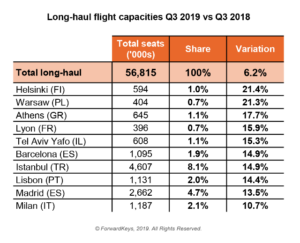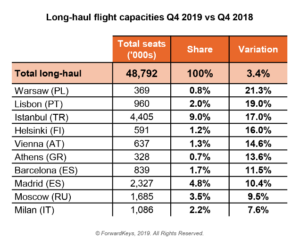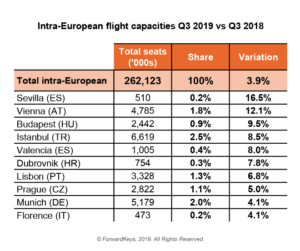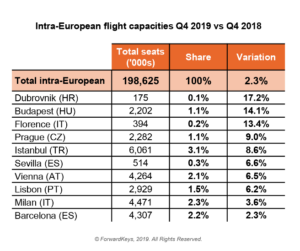As European cities increase air connectivity, Istanbul stands out

Olivier Ponti, VP Insights, ForwardKeys & Petra Stušek, ECM President
A study for World Cities Day on October 31st, undertaken by ForwardKeys, the travel analytics firm, in partnership with European Cities Marketing, reveals that European cities are more extensively connected by air to one and other and to the wider world than they have ever been. For their inhabitants, that can be a mixed blessing. On the positive side they are more convenient places to live and their economies benefit from visitors who come and spend money in their shops, hotels and restaurants. However, for a few, such as Amsterdam, Barcelona and Dubrovnik, managing the relentless growth in tourists is becoming a serious challenge, as residents are beginning to complain about rising prices and crowded streets, a scenario dubbed ‘overtourism’.
ForwardKeys reports that long-haul connectivity to European cities is growing strongly. Airlines appear confident, as seat capacity on flights from cities outside Europe, during the crucial third quarter of the year (Jul – Sep), grew by 6.2% compared to Q3 2018 and long-haul capacity for the fourth quarter (Oct – Dec) is 3.4% up on Q4 2018.
Connectivity between European cities is growing healthily too, all be it slightly less rapidly than it did last year. Intra-European airline seat capacity during Q3 (Jul – Sep) grew by 3.9% compared to Q3 2018.
Olivier Ponti, VP Insights, ForwardKeys, said: “Analysing airline seat capacities is a very helpful indicator of the size of the market because airlines are always trying to fill their planes and they can come close to that objective by flexing the price of tickets from one moment to the next. They can also reallocate aircraft between routes, if necessary, to cope with extraordinary demand. Q3 is the most important quarter of the year for Europe, as it embraces the busy summer season, which accounts for 34% of annual arrivals.”
During that period, Europe’s top cities for long-haul capacity growth were Helsinki, up 21.4%, Warsaw, up 21.3%, Athens, up 17.7%, Lyon, up 15.9%, Tel Aviv, up 15.3%, Barcelona, up 14.9%, Istanbul, up 14.9%, Lisbon, up 14.4%, Madrid, up 13.5%, and Milan, up 10.7%.

For the last quarter of the year, Warsaw is seeing the greatest long-haul capacity growth, the same growth as in Q3, an increase of 21.3%. Following Warsaw is Lisbon, up 19.0%, Istanbul, up 17.0%, Helsinki, up 16.0%, Vienna, up 14.6%, Athens, up 13.6%, Barcelona, up 11.5%, Madrid, up 10.4%, Moscow, up 9.5% and Milan, up 7.6%.

This summer, Seville topped the rankings for intra-European capacity growth, up 16.5%, followed by Vienna, up 12.1%, Budapest, up 9.5%, Istanbul, up 8.5%, Valencia, up 8.0%, Dubrovnik, up 7.8%, Lisbon, up 6.8%, Prague, up 5.0%, Munich, up 4.1% and Florence, up 4.1%.

Looking ahead to the final quarter of the year, Dubrovnik is in top spot, with airlines increasing intra-European capacity by 17.2% over Q4 2018. It is followed by Budapest, up 14.1%, Florence, up 13.4%, Prague, up 9.0%, Istanbul, up 8.6%, Seville, up 6.6%, Vienna, up 6.5%, Lisbon, up 6.2%, Milan, up 3.6% and Barcelona, up 2.3%.

Olivier Ponti commented: “Whilst cities like Dubrovnik, Florence, Helsinki, Seville and Warsaw are showing significant increases in capacity, they have done so from a relatively small base. The cities, which really stand out for increasing capacity from a larger base are Lisbon, Vienna and, most of all, Istanbul, which features in the top 7 cities for long haul and intra-European capacity growth in both Q3 and Q4. In the case of Istanbul, one has to attribute much of the success to the completion of its new airport, to the strength of Turkish Airlines and to the rise of two low cost carriers, Pegasus and Atlas Global, which are now the hub’s no.2 and no.3 airlines.”
Whilst high growth in visitor numbers is very good for the economy, creating jobs and earning foreign currency, it also has its challenges as city centres become increasingly crowded with tourists. Indeed, in some cities the locals have started to protest about ‘overtourism’, citing excessive crowds in the vicinity of major attractions, rowdy behaviour and rising property prices.
Petra Stušek, President, European Cities Marketing and Managing Director, Ljubljana Tourism, said: “I congratulate cities like Seville, which have done so well at improving connectivity and opening up new source markets. The ongoing growth in tourism to Europe is to be welcomed and it is a driver of prosperity. However, it should also be seen as creating new opportunities for cities to diversify their tourism offering and regenerate neighbourhoods away from the traditional city centre, with new hotels, restaurants, visitor attractions and improved urban realm.”
**ENDS**
European Cities Marketing is a non-profit organisation improving the competitiveness and performance of leading cities of Europe by providing a platform for convention, leisure and city marketing professionals to exchange knowledge, best practice and widen their network to build new business. European Cities Marketing is promoting and linking the interests of members from more than 115 major cities in 39 countries.
For more information and pictures, please contact Flavie Baudot, press@europeancitiesmarketing.com, +33 380 56 02 00
ForwardKeys helps its clients measure and improve the effectiveness of their marketing & operations; anticipate the impact of events; and capitalise on future trends. Its data scientists do so by analysing an unparalleled amount of air travel information to produce valuable insights into the profile, behaviour and impact of past, present and future travellers. Sources include airline capacity plus over 17m booking transactions and 7m flight searches per day. Customers are brands, retailers, duty-free specialists, financial institutions, media agencies and travel marketeers worldwide.
For further information, please contact:
Sophie Luis, Sophie.Luis@Tarsh.com on +44 (0) 20 7112 8556
or David Tarsh, David@Tarsh.com on +44 (0) 20 7602 5262
or visit www.ForwardKeys.com.